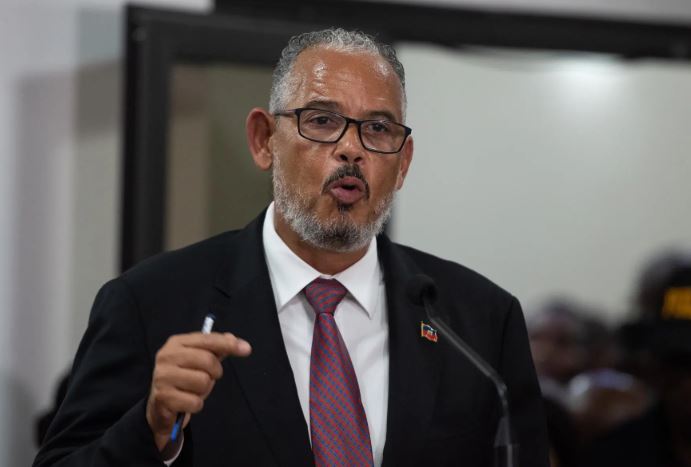PORT-AU-PRINCE (Le Floridien) — Haiti’s decision to resume domestic flights between Port-au-Prince and several provincial cities starting June 12 offers a glimmer of hope for a nation battered by insecurity and international isolation. Yet this domestic relaunch comes at a time when Haitians face deeper obstacles to international travel, particularly with no direct flights from the U.S. to Haiti and new immigration restrictions imposed by the Trump administration.
The resumption of flights, led by Sunrise Airways under an agreement with the Haitian government, will reconnect the capital with Cap-Haïtien, Jacmel, Les Cayes, and Jérémie. Government officials describe this step as a significant milestone in restoring internal mobility, supporting economic recovery, and signaling to international partners that Haiti is working toward a fragile normalization following months of turmoil.
“A necessary step forward,” said Prime Minister Alix Didier Fils-Aimé, calling the relaunch an advancement that will allow citizens to resume their activities and facilitate international transactions.

In February 2024, escalating gang violence forced the suspension of nearly all flights as airspace around the capital was deemed too dangerous. Gunfire near the Port-au-Prince airport in November 2024 led to a U.S. Federal Aviation Administration (FAA) ban on American commercial carriers, which has now been extended through September 2025. Airlines such as JetBlue and Spirit ceased operations after their planes were targeted on approach to Toussaint Louverture International Airport.
For Haitians in the provinces, the return of domestic air service could provide a crucial alternative to traveling on perilous roads dominated by gangs, where violent attacks, kidnappings, and extortion have become part of daily life. Leon Jean, a Haitian-American living in Florida who has family in Jacmel, views the resumption of flights as a necessary, if limited, step forward. “Right now, driving from Jacmel to Port-au-Prince is almost impossible for most families,” he said. “Being able to fly, even if it’s expensive, at least gives people an option to move safely within the country.”
High Ticket Prices Put Air Travel Out of Reach for Many
Still, many remain doubtful about how much impact the domestic flights will truly have. The cost of air travel puts it out of reach for most Haitians, with past round-trip fares between Cap-Haïtien and Port-au-Prince hovering around $300. So far, officials have not indicated whether prices will be adjusted to reflect the current economic hardship. Some worry that without improvements in airport security and affordability, the flights will mostly serve a small elite.
“Right now, these flights are for people with money, not for ordinary Haitians,” said Mirlande Joseph, a teacher in Pétion-Ville. “If they really want to help, they need to find a way to lower prices so more families can use them — otherwise, it’s just for show.”
Diaspora Weighs Challenges of Returning Home
For members of the Haitian diaspora, the announcement of resumed domestic flights is welcome news, but it does not solve the deeper challenge of reaching Haiti in the first place. With no direct U.S.-Haiti flights available, many travelers must first navigate complicated and costly routes through third countries before facing additional domestic flight expenses.
“I’m glad they’re reopening flights between the cities, but just getting to Haiti right now is hard enough,” Jean-Paul Deronvil, a Haitian living in Fort Lauderdale told Le Floridien. “I have to fly to the Dominican Republic first, then figure out how to safely cross the border to Cap-Haitien, or find another way into Port-au-Prince. Adding an expensive domestic ticket on top of that makes the whole trip very difficult for families like mine.”
The broader context further dampens the potential impact of this announcement. While domestic flights may help reconnect Haitian cities internally, the country remains cut off internationally. The FAA ban continues to prevent American airlines from flying to Haiti, and no U.S. carrier has scheduled a return before late 2025. This leaves the Haitian diaspora — especially the large communities in South Florida and the Northeast — without direct access to their homeland. Many are now forced to fly to the Dominican Republic or through Caribbean hubs like The Bahamas, significantly increasing the cost, duration, and risk of travel.
Making matters worse, on June 4 President Donald Trump signed a new executive order restricting immigration from 12 countries, including Haiti, citing “high risks in traveler screening and verification.” The measure, effective June 9, will further limit U.S. visa approvals for Haitians, already one of the most vulnerable migrant populations.
Haitian families who rely on U.S. visas for work, education, family reunification, or medical needs now face even greater uncertainty. The Haitian Ministry of Foreign Affairs has pledged to pursue diplomatic talks to reduce the impact of these new restrictions. “We call on our partners for an open discussion,” the ministry said in a statement, “to ensure that this decision does not worsen the situation for many Haitians.”
The combined effect of these factors is a two-tiered isolation. Haitians are physically isolated — with no direct international commercial flights from the U.S. — and increasingly subject to legal and bureaucratic restrictions on entering the U.S. Even as internal flights resume, the broader picture remains grim: families separated, businesses hampered, and humanitarian efforts constrained.
Government Hopes Domestic Flights Will Pave Way to Full Reopening
Prime Minister Fils-Aimé insists the domestic relaunch is intended to lay the groundwork for a gradual reopening to international air travel. “We are working to ensure that commercial flights to the regions become the first step toward resuming international travel,” he said.
Still, many Haitians remain cautious. Without substantial improvements in security and international diplomatic breakthroughs, Haiti’s aviation sector — and the mobility of its people — will remain severely limited. For now, the relaunch of domestic flights offers only a small bridge in a much wider sea of isolation.
